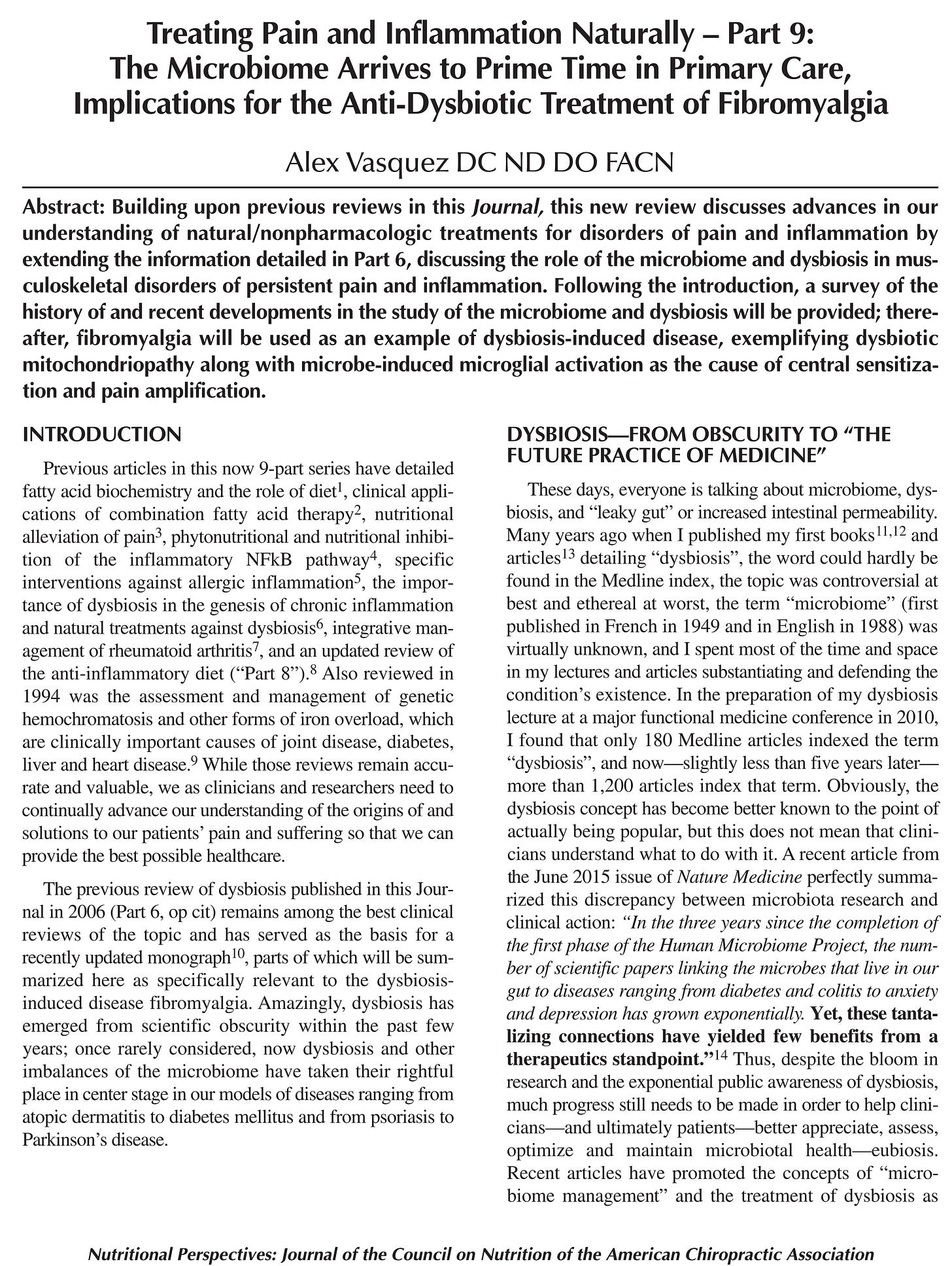Microbial Basis of Fibromyalgia and its AntiDysbiotic Treatment
Citations are available at the page hyperlinked at the bottom
Treating Pain and Inflammation Naturally—Part 9: The Microbiome Arrives to Prime Time in Primary Care, Implications for the Anti-Dysbiotic Treatment of Fibromyalgia
Alex Vasquez DC ND DO FACN
Abstract: Building upon previous reviews in this Journal, this new review discusses advances in our understanding of natural/nonpharmacologic treatments for disorders of pain and inflammation by extending the information detailed in Part 6, discussing the role of the microbiome and dysbiosis in musculoskeletal disorders of persistent pain and inflammation. Following the introduction, a survey of the history of and recent developments in the study of the microbiome and dysbiosis will be provided; thereafter, fibromyalgia will be used as an example of dysbiosis-induced disease, exemplifying dysbiotic mitochondriopathy along with microbe-induced microglial activation as the cause of central sensitization and pain amplification.
Introduction
Previous articles in this now 9-part series have detailed fatty acid biochemistry and the role of diet[1], clinical applications of combination fatty acid therapy[2], nutritional alleviation of pain[3], phytonutritional and nutritional inhibition of the inflammatory NFkB pathway[4], specific interventions against allergic inflammation[5], the importance of dysbiosis in the genesis of chronic inflammation and natural treatments against dysbiosis[6], integrative management of rheumatoid arthritis[7], and an updated review of the anti-inflammatory diet ("Part 8").[8] Also reviewed in 1994 was the assessment and management of genetic hemochromatosis and other forms of iron overload, which are clinically important causes of joint disease, diabetes, liver and heart disease.[9] While those reviews remain accurate and valuable, we as clinicians and researchers need to continually advance our understanding of the origins of and solutions to our patients' pain and suffering so that we can provide the best possible healthcare.
The previous review of dysbiosis published in this Journal in 2006 (Part 6, op cit) remains among the best clinical reviews of the topic and has served as the basis for a recently updated monograph[10], parts of which will be summarized here as specifically relevant to the dysbiosis-induced disease fibromyalgia. Amazingly, dysbiosis has emerged from scientific obscurity within the past few years; once rarely considered, now dysbiosis and other imbalances of the microbiome have taken their rightful place in center stage in our models of diseases ranging from atopic dermatitis to diabetes mellitus and from psoriasis to Parkinson's disease.
Dysbiosis—from Obscurity to "The Future Practice of Medicine"
These days, everyone is talking about microbiome, dysbiosis, and "leaky gut" or increased intestinal permeability. Many years ago when I published my first books[11],[12] and articles[13] detailing "dysbiosis", the word could hardly be found in the Medline index, the topic was controversial at best and ethereal at worst, the term "microbiome" (first published in French in 1949 and in English in 1988) was virtually unknown, and I spent most of the time and space in my lectures and articles substantiating and defending the condition's existence. In the preparation of my dysbiosis lecture at a major functional medicine conference in 2010, I found that only 180 Medline articles indexed the term “dysbiosis”, and now—slightly less than five years later—more than 1,200 articles index that term. Obviously, the dysbiosis concept has become better known to the point of actually being popular, but this does not mean that clinicians understand what to do with it. A recent article from the June 2015 issue of Nature Medicine perfectly summarized this discrepancy between microbiota research and clinical action: "In the three years since the completion of the first phase of the Human Microbiome Project, the number of scientific papers linking the microbes that live in our gut to diseases ranging from diabetes and colitis to anxiety and depression has grown exponentially. Yet, these tantalizing connections have yielded few benefits from a therapeutics standpoint."[14] Thus, despite the bloom in research and the exponential public awareness of dysbiosis, much progress still needs to be made in order to help clinicians—and ultimately patients—better appreciate, assess, optimize and maintain microbiotal health—eubiosis. Recent articles have promoted the concepts of "microbiome management" and the treatment of dysbiosis as playing major roles in "the future practice of medicine" but have failed to provide clinically actionable information. The basic science and clinical research data on these various phenomena is crystal clear and intellectually sound but is rarely delivered in a manageable manner so that time-pressured clinicians can perceive the information in an interconnected context that expedites clinical application in patient assessment and treatment. Dysbiosis is an important concept, but doctors cannot treat concepts; we have to define, describe, and deconstruct the microbes, molecules, and mechanisms into their components, then rebuild a conceptual scaffold and intellectual structure that becomes a useful tool that, with study and experience, can be used in a clinical setting to effective benefit.[15]
Fibromyalgia—Drug Deficiency or Dysbiosis-Induced Central Sensitization and Mitochondrial Dysfunction?
The persistent widespread body pain that characterizes fibromyalgia has peripheral (e.g., mitochondrial and inflammatory) and central (i.e., brain and spinal cord) origins. Central sensitization describes the phenomenon characterized by increased sensitivity in the brain and spinal cord to pain signals and signals interpreted as pain which would not otherwise be perceived as such. Peripheral abnormalities seen in fibromyalgia include mitochondrial dysfunction, intestinal hyperpermeability, systemic inflammation, DNA damage, oxidative stress; obviously these abnormalities do not originate from within the central nervous system but are generated from elsewhere in the body.
The "drug deficiency model of fibromyalgia" postulates that the condition is idiopathic and therefore necessarily treated with pharmaceutical drugs. According to the American Pain Society in May 2015, fibromyalgia is a "chronic" pain disorder that originates from the brain and spinal cord and requires treatment with analgesic drugs.[16] Despite the mountain of research substantiating the integrated model of the microbial and metabolic origins of fibromyalgia[17], science writers funded by drug companies describe central sensitization as idiopathic and necessarily treated with pain-relieving drugs; noteworthy is the fact that all of the FDA-approved drugs for fibromyalgia are expensive (range $100-200 per month per drug) and have adverse effects including weight gain, seizures, life-threatening allergic reactions, hepatic toxicity, depression, suicide, and other causes of injury and death.[18]
The "microbial and metabolic model of fibromyalgia" shows that small intestinal bacterial overgrowth (SIBO) which is common in clinical practice is notably more common—up to 100% in some studies—in patients with fibromyalgia and that the severity of SIBO correlates with the severity of fibromyalgia, thereby supporting a dose-dependent causal relationship. Central sensitization can result from exposure to microbial molecules such as bacterial endotoxin and the resulting inflammatory response which triggers Toll-like receptor 4 (TLR4) in the brain's microglial cells, causing astrocytes to promote excitatory glutaminergic neurotransmission[19] which promotes pain perception, depression, central fatigue, and neurodegeneration. Consistent with this model is the finding that microbial metabolites from gastrointestinal bacteria such as hydrogen sulfide (H2S) and D-lactate can induce mitochondrial dysfunction, as can bacterial lipopolysaccharide (LPS, endotoxin). This model explains why fibromyalgia patients respond to treatments that support mitochondrial function (e.g., coenzyme Q10 300 mg/d[20]) as well as treatments that directly address the small intestine bacterial overgrowth (SIBO).[21]
The complete fibromyalgia protocol is published in Chapter 5 of Inflammation Mastery, and dysbiosis is extensively covered in Chapter 4.
Sample PDF downloads:
Click here to see the first few pages, including the table of contents and index (size: 6 MB)
Click here for a larger sample with photos (size: 43 MB)







